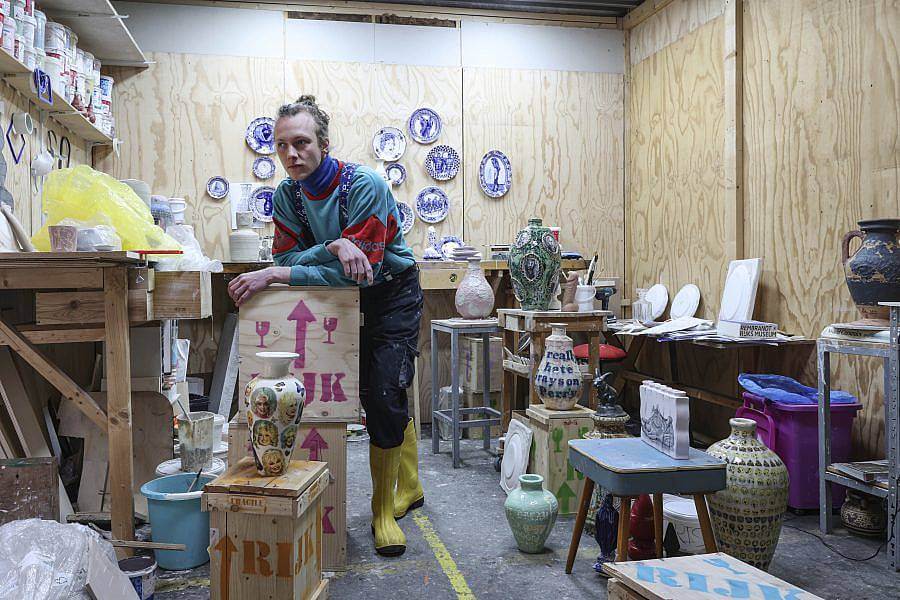Tell us a little bit about yourself and what you do.
I am an artist pretending to be a potter. I started out as a painter, but with a few detours my work became an unstoppable stream of pottery. Though traditionally shaped, and on first glance their decoration might look accordingly, if you blink a few times they are unmistakably contemporary vessels. Their imagery illustrates the quirks of life at the beginning of the twenty-first century: the secret language of brand logos and emojis, identity politics in overdrive, the art world, artist-hood, and the concept of extreme masculinity [or] my much lamented lack thereof. Over the last year I started to distinguish two types of work I make. One that could be called colorful slipware, and the other Dutch Delftware. They’re two different worlds really, as their techniques are so fundamentally different.
The slipware takes a long time to make, making the pot, building up the layers of slip and then drawing, stamping and cutting-out the decorations. Moreover, working like this requires a very strict order in which to apply the decoration and there is almost no room for spontaneous ideas. Also, everything is done before the first firing, meaning that if it explodes in the kiln, months of work is wasted. Making a piece this way is rather an investment.
The Delftware are quite the opposite. While the colorful pots could be chapters in a novel, the Delft works are diary entries. I’m having lots of fun painting them and it still feels like a relief to have brought some speed into my practice. Often, they are very erotic. When they are not, I use them to say something about Dutch culture or the Netherlands in general. I’m not quite sure how it is perceived in other countries, but here in the Netherlands Delftware immediately summons feelings of ye olde republic, it’s our pride but we also love to hate it.
I’m now working on a pot titled Disneyland Zaandam; the latter is the village where my studio is, and it’s the cradle of what foreigners perceive as Dutch: windmills, tulips, clogs and cute wooden houses. They tried to zhoosh up the city center with outrageous architecture, and I have something to say about that.
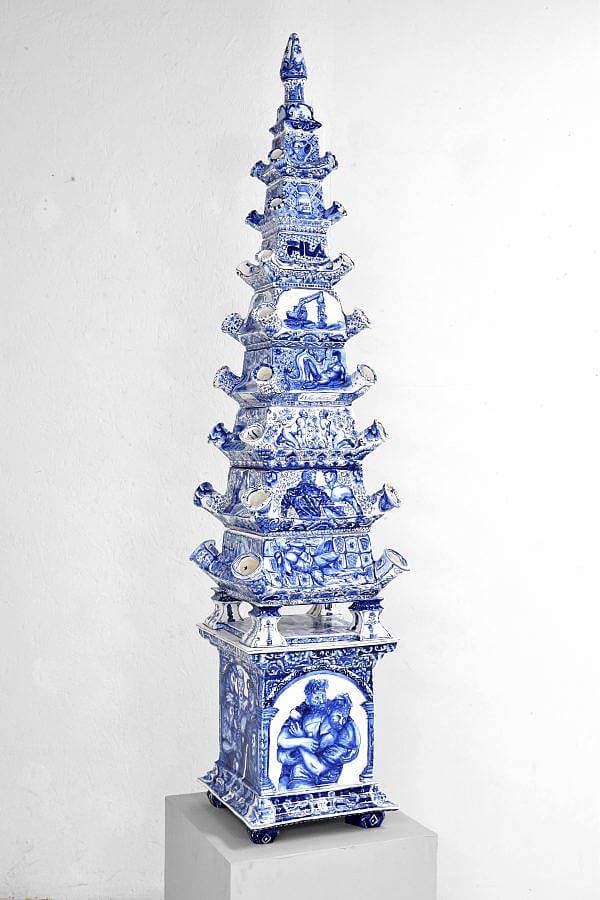
What are some of your biggest sources of inspiration?
My partner once accused me of being a building with all its windows wide open, because too many smells, sounds and people make me go mad; I don’t really manage to filter unimportant impressions out. I’m thinking of that remark now, because it has an up-side as well. When I’m under the shower or walking home from the studio are moments I think my mind is relaxing, but in fact it’s working super hard to process information. Impressions blow into my portholes and without much effort my mind regularly issues an idea that is a combination of that input: things I overheard others say, dull one liners I read, the news or just thoughts. I’m a bit reluctant to say, but I’m afraid the world around me involuntarily inspires me.
Fortunately, I can add that I have another big and more exciting source of inspiration: my extensive image archive. It’s a filing cabinet with folders titled for example: the male body, with the subfolders: big and hairy, dicks, scally lads – even-though I never really understand what defines a scally lad – butts and underpants, Jesus Christ and Sebastian. There’s a folder called peeing farmer, working men, condom, and one called women. There are also more innocent folders called decorative motifs and flowers, but despite those, my ‘archive’ is a collection of porn images, but an inspiration nonetheless. When I feel like it, I just go through it, take some images out, refile some pictures and before I know it I’m occupied for the next couple of days.
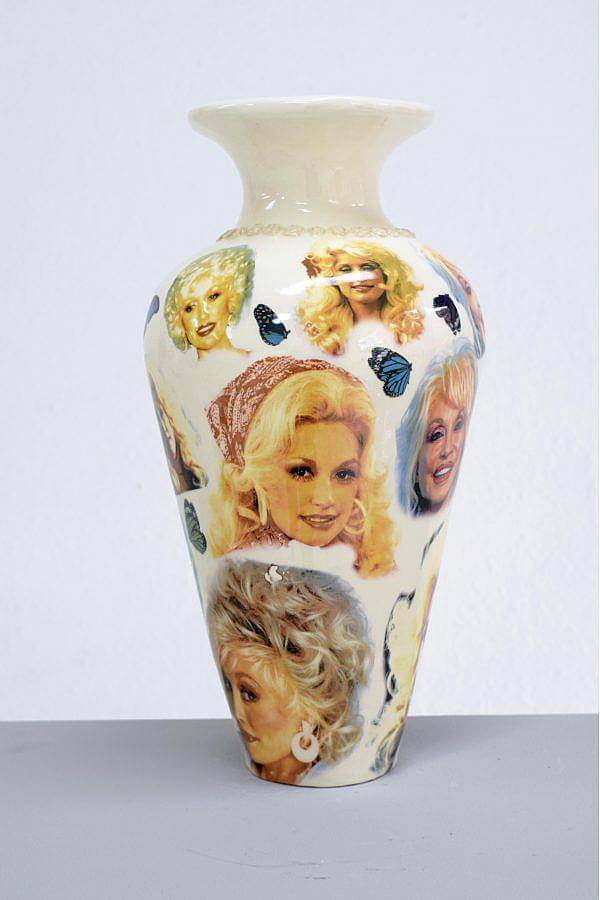
I’m intrigued by your usage of pop culture imagery in your work (for example, Life and Lies of Dolly Parton). How do you go about selecting these images and what do they represent to you personally?
I just like [Dolly Parton] a lot. Also, I really enjoy the idea of a future archaeologist digging up this vase, or better yet: a few shards of it, and without a doubt they will conclude that this must be some kind of powerful ancient queen, a Venus or a deity.
It’s probably a bit perky but these thoughts really became part of my work, for I think there is a big chance it will stand the test of time. Not at all for its artistic value – but just for the nature of the material: Mother Earth has a hard time digesting ceramics. One could argue that archaeologists have to search very hard among tons of toilet bowls, bathroom tiles and IKEA dinnerware, but working hard is good for people.
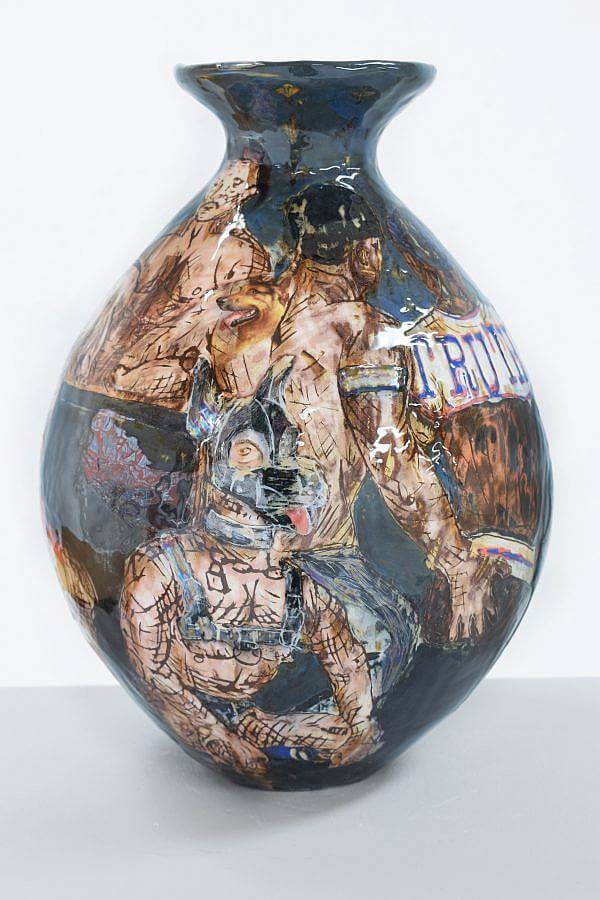
Glazed stoneware,
2020
I love your combination of queer imagery and the medium of ceramics (for example, your piece Truth, beauty, and seriousness sat in a bar , and your Platters series). What draws you to the combination of this imagery and medium?
For me, the fact that the imagery is queer or whatever doesn’t have much meaning. I’m gay – so I see the world through those glasses. I would say I use sexual or erotic images as a motif, not as subject as such. I have always suppressed the itch of making sexual work because it seemed like the easy way to go. [Ever] since I allowed myself to go down this road, I obviously started to think more about it and why there is this urge. Now I cannot disconnect clay, ceramics, and sex anymore, for I think the similarities are so numerous:
Clay and sex are both cheap, mundane and they make your hands dirty. Clay is like flesh and it’s fertile. In Dutch paintings pottery is a sexual symbol and body parts are used to describe a vase: the foot, neck, shoulders, lip, belly. While sex is essential for the human species to continue to exist as part of nature, ceramics has showed itself indispensable for documenting and preserving the human culture. In that light I like to see my pots as time capsules: testaments and storage vessels of our stupid, ignorant and primitive times.
All these stirrings of the soul aside: Delftware is considered granny-like and frumpy in the Netherlands, so I’m having a good laugh about combining flowers and frills with hairy bums. My potter-friendly G.P. from neighboring country said that ceramics are so innocent, the vice squad will never raid a pottery exhibition, which makes this medium perfect for depicting all kinds of dark and horny fantasies.
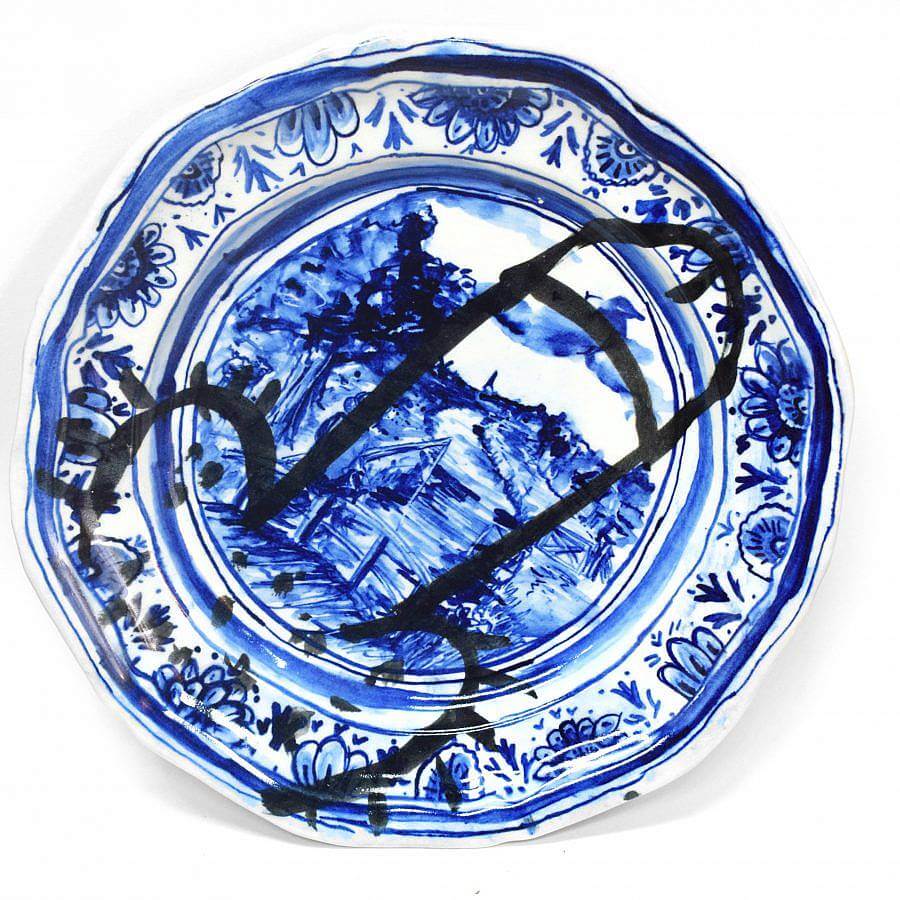
Many of your pieces have an element of humor to them. I’m curious as to what way, if any, your personal stories / experiences play into your work?
My first inkling was that my work isn’t personal at all… As if! My work is mainly about me, or at least, that’s the starting point. Art should be personal and universal at the same time, right?
When I started working on my big tulip vase – Chris Rijk, the Penniless Artist (Rijk, my name, means rich) – I had a lot of thoughts and ideas about what the work had to be about, the message I wanted to convey, and blah blah. But along the way, also due a rapidly approaching deadline, it ended up as a phallic tower with sexy men. It was the first big Delft work I made and I think of it as the precursor for everything that came after: it’s about the man I really would like to be (big, hairy, muscled, sturdy and with a low voice) but that I am not ( a potter).
I would say it’s a bit perverse to consider my work not personal, because of course it is: I recently created a pot titled: ‘’My Dick, This Vase and Other Big, Long Things.’’ Earlier this year, one called ”I Really Hate Grayson Perry”. Before that [I created]: ‘’With All Due Respect’’ showing pictures of works of mine with written over it things others said about my work: ‘’UGLY! GIRLY! TASTELESS! DO YOU HAVE SEXUAL ISSUES?’’ Its counterpart became a tulip vase titled: ‘’The Compliments With Which I Pay My Bills.’’
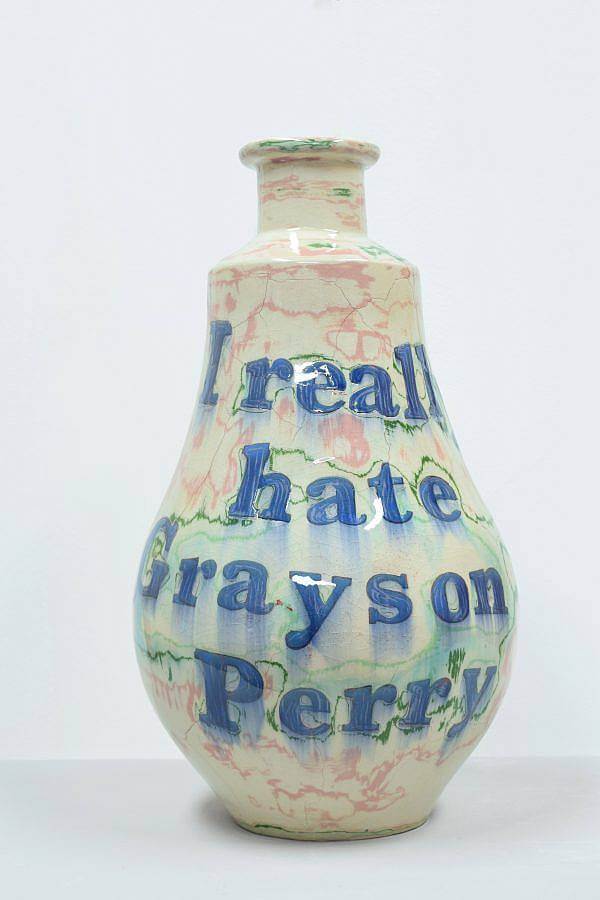
Many of your pieces reference traditional pottery forms. How do you see your pieces fitting in with / not fitting in with traditional ceramic practices?
I like to say that I don’t make pots, they just look like pots. They’re not quite functional for starters, and I solely see them as image carriers. I always wanted to be a painter, but I couldn’t cope with the rectangle of the frame and the abstraction a canvas is. A pot is not at all abstract because it is a pot. It provides a very clear framework, it has a bottom and a top, so no arrows on the backside needed to reveal the upside. Moreover: everyone knows what a vase is. I dare to even go as far as to say that maybe everyone possesses a vase.
In contrast to a canvas, the shape of the pot (or the fact it is a pot) is part of the meaning of the work and there is a convenient abundance of historic shapes to choose from. I never made a shape I didn’t copy from an existing pot. Having said all this, I consider myself a visual artist masquerading as a potter.
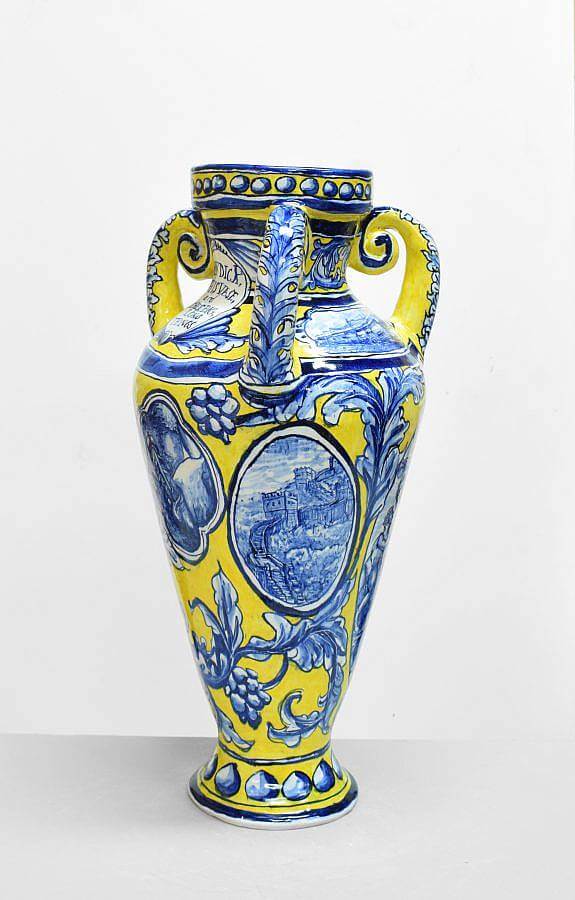
How has living in The Netherlands shaped your practice?
While the surrounding countries, France, Germany, the United Kingdom, have extensive pottery traditions and grace the pages of historic overviews in almost all eras, the Dutch only make an appearance in the seventeenth century with their Delftware: pristine imitations of Chinese blue and white porcelain.
Some people think of the Dutch as being blessed with mercantilism, and while Delftware was a commercially wise choice, I also make work that will only be understood by my countrymen. I use lots of Dutch texts to begin with, and refer to literature, cultural phenomena and certain types of music- our equivalent to the French chanson, but 100.000 times more lowbrow. Those don’t really define my practice per se, but I suppose it is the cross we have to bear not being brought up in the US of A.
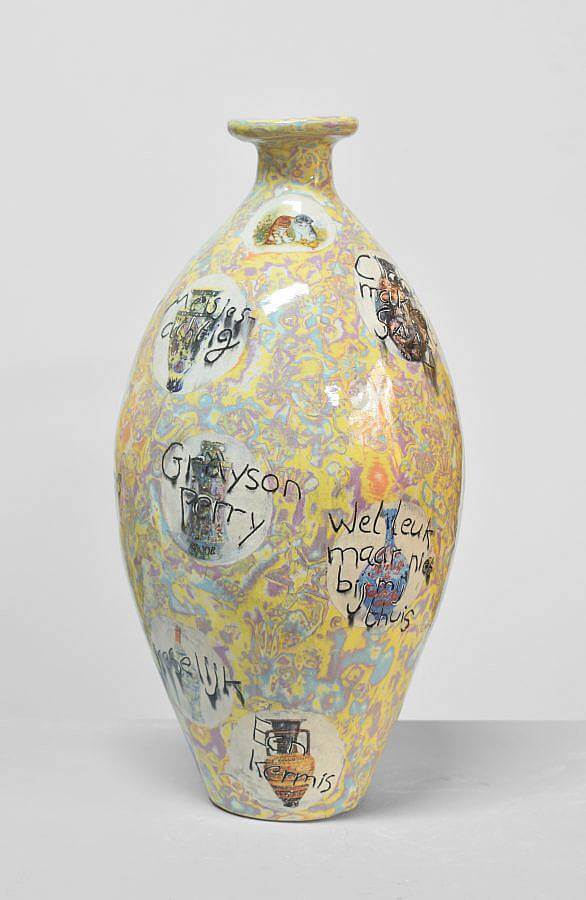
How has your art practice changed / evolved over the years?
In art school, students are encouraged to try out everything, and so I did. However, over those four years I slowly eliminated every medium until I didn’t make anything anymore and was just busy collecting stuff and calling it my work. In my final year, I concluded that this nihilistic approach might not be the way to go, and thus, I decided to make use of all the facilities the school had to offer. I graduated with mainly ceramics and some background noise in the shape of three meter high pedestals and an equally giant concrete buttplug. A year or so after I felt a bit clueless because I graduated with top marks, but no-one in the real world thought of me as the genius my teachers thought I was. When someone gave me a small, ancient, kiln things changed. Finally I found back the joy of working with clay, however ugly my pots were. I’m not a trained ceramist so there were plenty of practical questions I had.
The European Ceramic Work-Center (EKWC), conveniently based in the Netherlands, offered a solution. I thought of it as quite prestigious, or at least difficult to get in so I applied thinking: then at least they know of my existence. But to my surprise, delight, and honor they accepted me as one of their youngest participants ever and so I entered a potters paradise. The EKWC is a residency program offering a place to work and stay for three months. After taking on the bizarre financial hurdle, it’s really the best spot to be: they have huge kilns, all the facilities one could wish for, and most important for me: the technical know-how. They prefer to accept projects that are supposedly impossible for then it’s likely to spark innovation, but unwilling to be stuck for the rest of my life with unmanageably big butt plugs, which is what I fantasized about, I went with very practical questions: What is glaze exactly? What is clay and how to knead it? How does a kiln work? How to furnish a ceramics studio? The result, nonetheless, is a series of pots I consider the start of my career. That was the beginning of 2020 and from there I developed my skills, found out about Delftware, [participated in] exhibitions, worked with a gallery, then joined another one. That all led up to answering this question in this interview.

What does your studio setup / workspace look like?
It’s not quite extraordinary. There’s storage, a big table that serves as a desk on which I paint my blue work (but unavoidably is storage too), a small kiln on wheels, and a space where I work with clay. Then we have a communal ceramics workshop where I make my glazes and keep my big kilns.
What are you currently listening to?
Nothing but my fingers diligently typing out this answer.
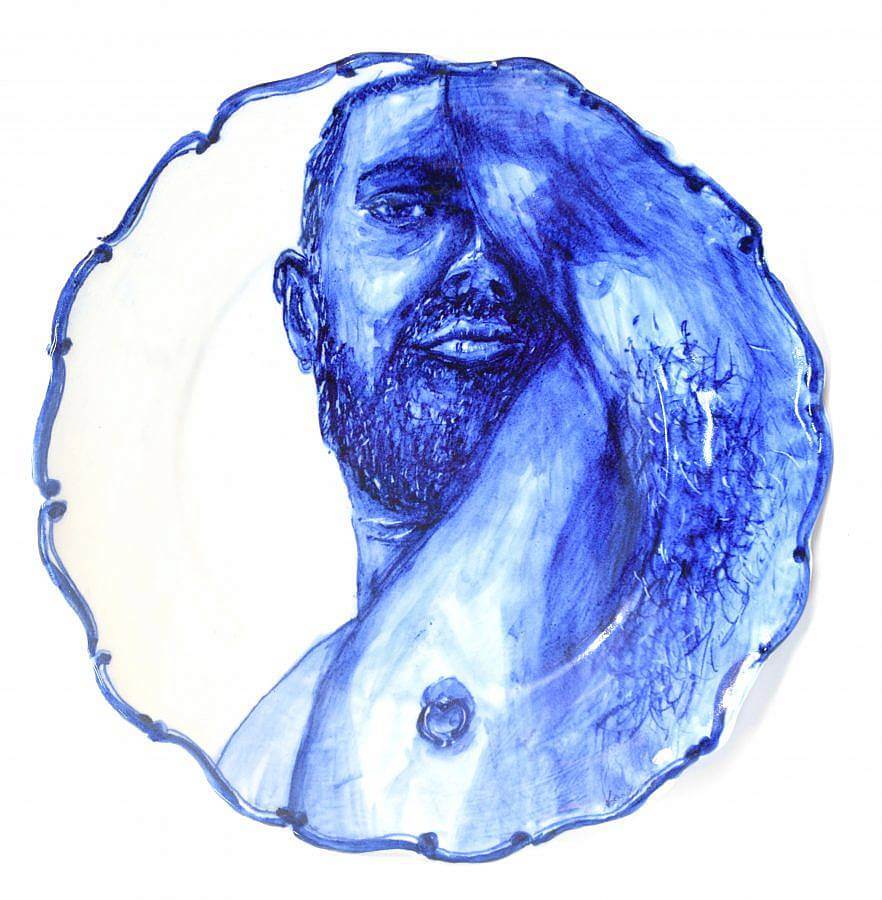
Any upcoming projects you are excited about?
I recently joined Rademakers Gallery in Amsterdam, and they have plenty of cool things in store. PAN Amsterdam for example, a fair I always thought focussed on antiques, but apparently they have contemporary art too. So there my role as Delftware invader will be put to the test.
In terms of projects in the studio, I started to make a bit more sculptural work. A urinal, and a pair of something I don’t really know what to call in English. According to wikipedia: a pole on a pavement to prevent undesirable parking, and to separate the driveway from the sidewalk. They are decorated with the three crosses of the Amsterdam city weapon and are a symbol of the city. They’re sold as chocolates and other knick-knacks for tourists, and due to their design they are seen as phallic symbols.
Interview conducted and edited by Ben Herbert.
